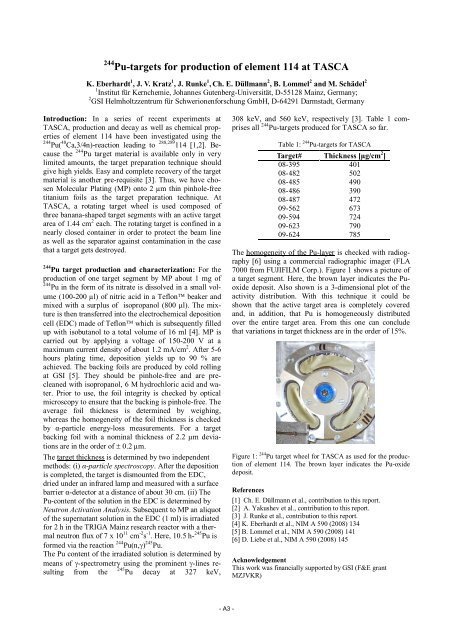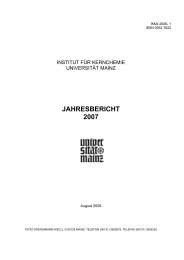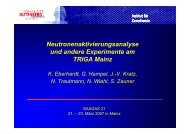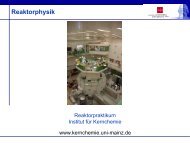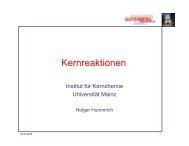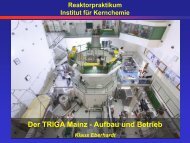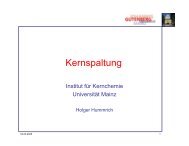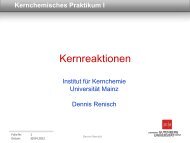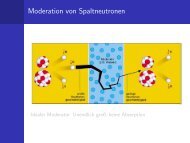institut für kernchemie universität mainz jahresbericht 2009
institut für kernchemie universität mainz jahresbericht 2009
institut für kernchemie universität mainz jahresbericht 2009
Create successful ePaper yourself
Turn your PDF publications into a flip-book with our unique Google optimized e-Paper software.
GSITemp late2007<br />
244 Pu-targets for production of element 114 at TASCA<br />
K. Eberhardt 1 , J. V. Kratz 1 , J. Runke 1 , Ch. E. Düllmann 2 , B. Lommel 2 and M. Schädel 2<br />
1 Institut <strong>für</strong> Kernchemie, Johannes Gutenberg-Universität, D-55128 Mainz, Germany;<br />
2 GSI Helmholtzzentrum <strong>für</strong> Schwerionenforschung GmbH, D-64291 Darmstadt, Germany<br />
Introduction: In a series of recent experiments at<br />
TASCA, production and decay as well as chemical properties<br />
of element 114 have been investigated using the<br />
244 Pu( 48 Ca,3/4n)-reaction leading to 288,289 114 [1,2]. Because<br />
the 244 Pu target material is available only in very<br />
limited amounts, the target preparation technique should<br />
give high yields. Easy and complete recovery of the target<br />
material is another pre-requisite [3]. Thus, we have chosen<br />
Molecular Plating (MP) onto 2 µm thin pinhole-free<br />
titanium foils as the target preparation technique. At<br />
TASCA, a rotating target wheel is used composed of<br />
three banana-shaped target segments with an active target<br />
area of 1.44 cm 2 each. The rotating target is confined in a<br />
nearly closed container in order to protect the beam line<br />
as well as the separator against contamination in the case<br />
that a target gets destroyed.<br />
244<br />
Pu target production and characterization: For the<br />
production of one target segment by MP about 1 mg of<br />
244<br />
Pu in the form of its nitrate is dissolved in a small volume<br />
(100-200 µl) of nitric acid in a Teflon� beaker and<br />
mixed with a surplus of isopropanol (800 µl). The mixture<br />
is then transferred into the electrochemical deposition<br />
cell (EDC) made of Teflon� which is subsequently filled<br />
up with isobutanol to a total volume of 16 ml [4]. MP is<br />
carried out by applying a voltage of 150-200 V at a<br />
maximum current density of about 1.2 mA/cm 2 . After 5-6<br />
hours plating time, deposition yields up to 90 % are<br />
achieved. The backing foils are produced by cold rolling<br />
at GSI [5]. They should be pinhole-free and are precleaned<br />
with isopropanol, 6 M hydrochloric acid and water.<br />
Prior to use, the foil integrity is checked by optical<br />
microscopy to ensure that the backing is pinhole-free. The<br />
average foil thickness is determined by weighing,<br />
whereas the homogeneity of the foil thickness is checked<br />
by �-particle energy-loss measurements. For a target<br />
backing foil with a nominal thickness of 2.2 µm deviations<br />
are in the order of � 0.2 µm.<br />
The target thickness is determined by two independent<br />
methods: (i) �-particle spectroscopy. After the deposition<br />
is completed, the target is dismounted from the EDC,<br />
dried under an infrared lamp and measured with a surface<br />
barrier �-detector at a distance of about 30 cm. (ii) The<br />
Pu-content of the solution in the EDC is determined by<br />
Neutron Activation Analysis. Subsequent to MP an aliquot<br />
of the supernatant solution in the EDC (1 ml) is irradiated<br />
for 2 h in the TRIGA Mainz research reactor with a thermal<br />
neutron flux of 7 x 10 11 cm -2 s -1 . Here, 10.5 h- 245 Pu is<br />
formed via the reaction 244 Pu(n,�) 245 Pu.<br />
The Pu content of the irradiated solution is determined by<br />
means of �-spectrometry using the prominent �-lines re-<br />
245<br />
sulting from the Pu decay at 327 keV,<br />
308 keV, and 560 keV, respectively [3]. Table 1 comprises<br />
all 244 Pu-targets produced for TASCA so far.<br />
Table 1: 244 Pu-targets for TASCA<br />
Target# Thickness [µg/cm 2 ]<br />
08-395 401<br />
08-482 502<br />
08-485 490<br />
08-486 390<br />
08-487 472<br />
09-562 673<br />
09-594 724<br />
09-623 790<br />
09-624 785<br />
The homogeneity of the Pu-layer is checked with radiography<br />
[6] using a commercial radiographic imager (FLA<br />
7000 from FUJIFILM Corp.). Figure 1 shows a picture of<br />
a target segment. Here, the brown layer indicates the Puoxide<br />
deposit. Also shown is a 3-dimensional plot of the<br />
activity distribution. With this technique it could be<br />
shown that the active target area is completely covered<br />
and, in addition, that Pu is homogeneously distributed<br />
over the entire target area. From this one can conclude<br />
that variations in target thickness are in the order of 15%.<br />
Figure 1: 244 Pu target wheel for TASCA as used for the production<br />
of element 114. The brown layer indicates the Pu-oxide<br />
deposit.<br />
References<br />
[1] Ch. E. Düllmann et al., contribution to this report.<br />
[2] A. Yakushev et al., contribution to this report.<br />
[3] J. Runke et al., contribution to this report.<br />
[4] K. Eberhardt et al., NIM A 590 (2008) 134<br />
[5] B. Lommel et al., NIM A 590 (2008) 141<br />
[6] D. Liebe et al., NIM A 590 (2008) 145<br />
Acknowledgement<br />
This work was financially supported by GSI (F&E grant<br />
MZJVKR)


